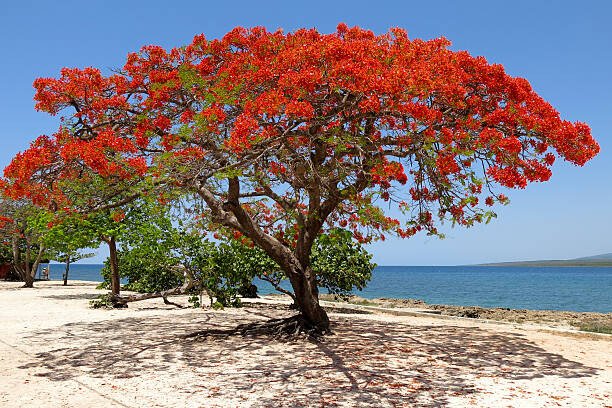
Flame Tree and Planting: Adding Vibrance to Your Landscape
Table of Contents
- Introduction
- The Beauty of Flame Trees
- Choosing the Right Location
- Selecting the Ideal Time for Planting
- Preparing the Soil
- Planting Your Flame Tree
- Providing Adequate Watering
- Mulching for Healthier Growth
- Pruning and Shaping Your Tree
- Dealing with Pests and Diseases
- Benefits of Flame Trees in Your Landscape
- Creating a Stunning Visual Impact
- Frequently Asked Questions (FAQs)
- What is the optimal climate for flame trees?
- How often should I water my newly planted flame tree?
- Are flame trees prone to specific diseases?
- Can I grow a flame tree in a container?
- Do flame trees attract wildlife?
Introduction
Adding a touch of natural beauty to your landscape not only enhances the aesthetic appeal but also enriches the environment. One such majestic addition is the flame tree (Delonix regia), renowned for its vibrant and fiery blooms that create a stunning visual spectacle. In this article, we’ll explore the art of planting and caring for flame trees, transforming your outdoor space into a haven of color and life.
The Beauty of Flame Trees
Flame trees, with their striking red, orange, and sometimes even yellow blossoms, have earned their place as a symbol of tropical elegance. These deciduous trees can grow to impressive heights, making them focal points in any garden or park.
Choosing the Right Location
Selecting the perfect spot for your flame tree is crucial. Ensure it receives ample sunlight to encourage healthy growth and abundant flowering. A well-drained area with enough space for the tree to spread its branches is ideal.
Selecting the Ideal Time for Planting
Planting your flame tree during the right season is key to its successful establishment. Spring, when the threat of frost has passed and the soil is warming up, is the prime time for planting.
Preparing the Soil
Flame trees thrive in slightly acidic to neutral soil. Conduct a soil test to determine its pH level and amend it accordingly. Incorporate organic matter to enhance drainage and fertility.
Planting Your Flame Tree
Dig a hole slightly larger than the tree’s root ball. Gently remove the tree from its container and place it in the hole at the same depth as it was in the container. Backfill with soil, tamp it down, and water thoroughly.
Providing Adequate Watering
Regular watering is essential, especially during the first few months after planting. Keep the soil consistently moist but not waterlogged. Adjust the frequency based on weather conditions.
Mulching for Healthier Growth
Applying a layer of organic mulch around the base of the tree helps retain moisture, suppress weeds, and regulate soil temperature. Maintain a gap around the trunk to prevent moisture buildup.
Pruning and Shaping Your Tree
Pruning helps shape the flame tree and remove dead or diseased branches. Prune during the dormant season, and avoid excessive cutting, as it may impact flowering.
Dealing with Pests and Diseases
Monitor your tree for signs of pests or diseases, such as aphids or powdery mildew. Regular inspections and appropriate treatments, including natural remedies, can help maintain tree health.
Benefits of Flame Trees in Your Landscape
The presence of flame trees goes beyond their breathtaking beauty. These trees provide shade, improve air quality, and attract pollinators, contributing to the overall health of your garden ecosystem.
Creating a Stunning Visual Impact
Imagine stepping into your garden and being greeted by the vibrant hues of flame tree blossoms. The visual impact is undeniable, creating a picturesque scene that’s both captivating and serene.
Conclusion
Planting and nurturing a flame tree requires patience and care, but the rewards are abundant. As your flame tree flourishes and graces your landscape with its brilliant colors, you’ll find yourself enchanted by the magic of nature.
Frequently Asked Questions (FAQs)
What is the optimal climate for flame trees?
Flame trees thrive in tropical and subtropical climates with warm temperatures and plenty of sunlight.
How often should I water my newly planted flame tree?
Water your newly planted flame tree regularly, ensuring the soil remains consistently moist but not waterlogged.
Are flame trees prone to specific diseases?
Flame trees can be susceptible to diseases like powdery mildew and leaf spot. Regular monitoring and proper care can help prevent and manage these issues.
Can I grow a flame tree in a container?
While flame trees prefer open spaces, some smaller varieties can be grown in containers. Ensure the container is large enough and provide proper care for optimal growth.
Do flame trees attract wildlife?
Yes, flame trees attract pollinators like bees and butterflies, enhancing biodiversity in your garden. They can also serve as habitat for birds and insects.